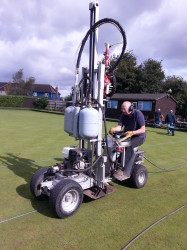
Along with leaves, November also presents peak season for worm casting activity. With the withdrawal of Carbendazim, the time to finally focus on cultural controls has arrived. Switching and brushing dried worm casts on bowling and golf greens on a regular basis, and especially prior to mowing, is very important to reduce smearing.
It is important to continue aeration by whatever means available, so long as ground conditions are not too wet. This will maintain soil profile respiration and healthy air water ratios; factors which will facilitate healthy populations of vital soil biology, happy plants and efficient drainage.
Key Tasks for November

- Maintain a winter height cut of 10-12mm
- Carry out inspection and maintenance of machinery and irrigation equipment
- Service equipment and replace any worn or damaged parts.
- Check for diseases and pests, seek advice if necessary
- Aerate when conditions allow
- Clean up any leaf debris
- Drag brush daily
- Spike, if and when possible, and only if conditions are right
- Maintenance of fences and hedges




As ever, decisions on agronomic inputs are governed by climactic conditions. October witnessed certain extremes with Atlantic storms delivering forceful winds and heavy rain to the west of the British Isles whilst many other areas simultaneously experienced unseasonal warmth and, for some periods, even sunshine.
Such variability necessitates turf managers at all levels to keep themselves informed of upcoming weather forecasts and also ensure they are suitably prepared with the relevant inputs in stock. This means they are then able to react to application windows swiftly and decisively. Reference to growth degree and growth potential forecasts further allow managers to time inputs when the plant is the most receptive to efficient uptake and utilisation.
Traditionally, November brings with it short, dull days with plenty of rainfall and stormy weather, potentially good for removing leaves off the trees but less favourable for good turf conditions.
November then is a good time to be mindful of good sound cultural practices.
- Remove dews to minimise periods of leaf blade wetness, thereby reducing humidity in the sward canopy and helping to prevent fungal pathogen advance.
- Aerate little and often whenever ground conditions allow to facilitate balanced soil water/air ratios, maintaining aerobic conditions and supporting beneficial soil microorganisms.
- Remove leaves from surfaces to prevent microclimates which promote conditions for pathogen attack and also weaken the plant, making it further susceptible.
- Raise mowing heights to increase leaf surface area and accordingly help the plant to compensate for reduced day length by maintaining photosynthesis potential (the plants energy factory), such that plants can maintain healthy and efficient metabolic function.
Nutritional inputs should be applied with the aim of maximising plant health and resilience through November in a bid to prepare the plant, and thus surfaces, to better cope with the oncoming rigours of December, January and February.
From a feed perspective, adequate nitrogen for plant function is all that is required; forcing growth for aesthetics or recovery from disease scars potentially risks increasing susceptibility to pathogens.
Pay close attention to the secondary micronutrients, sulphur, calcium and magnesium as well as the assorted micronutrients. No one nutrient is more important than the other, they are just required in different quantities. Identifying deficiencies and topping up plant levels with liquid applications is the best way to provide a healthy balanced diet which will allow the plant to be happier, healthier and more resilient in the coming months.
Wetting agents are a go to item at the start of the season with an eye on preventing drought and dry patch. Correct water management should be a prime concern all through the year, with penetrant wetting agents designed to drive water through the profile being the tool of choice from October and November onwards.
Biostimulants are still useful tools through November, whether it be seaweed, sugar or humic substances. Applications should be timed during periods of low disease pressure when they will be most useful to the plant and its associated beneficial microorganisms. Avoid applications during times of pathogenic pressure so as not to further facilitate their function.
Disease management is due to become more challenging following the recent EU vote to not renew the approval of Iprodione on the grounds of human health concerns (Iprodione is an endocrine disruptor). Notification of withdrawal is expected in December, with end of sale and use/disposal of stocks expiry dates expected to come into effect around March and June respectively.
October, November December 2017 then are the last peak fungal disease months where turf managers will be afforded the luxury of a ‘knock it on the head’ active ingredient with which to act reactively to visible signs of disease attack, whether that be mycelium or scarring.
For many months, these diaries have sought to promote the message of Integrated Turf Management with respects to proactive, preventative disease management. Rather than an option, that principle is a rapidly approaching as a necessity.
Anyone seeking further help and advice on such matters should not be afraid to reach out and seek assistance, whether that be from informed peers who are already successfully utilising such techniques, or by telephoning Pitchcare and asking to speak to one of eight BASIS registered advisors, all of whom are trained and accredited in the latest legislative and management practices.
It is important to maintain machines by carrying out regular servicing and repairs.
As grass growth slows down, use the time to take some machines out of operation for an overhaul.
- Keep machines overhauled and clean
- Maintain a stock of consumables for your machinery, replace worn and damaged parts as necessary.
- Keep an eye on your material stocks (seed, topdressing, petrol, oil), remembering to replenish as required.
- Service machinery and equipment - changing oil / air filters and greasing up moving parts and sharpening mower blades.

Pitchcare is the only provider of LANTRA accredited training courses in the maintenance of Bowls Greens. More information
We can also arrange Lantra accredited training on site to groups of 6 – 10 people. Email Chris Johnson for information.
The Course Manual at just £30 is available for purchase separately.
At this time of the year, when the weather allows, a general tidy-up of areas around the green makes all the difference; this would include tasks such as hedge cutting, clearing ditches, painting club house, weeding paths and borders.
Check and inspect ditches, floodlights, structures and any site furniture for damage; keep the site clean and maintain a tidy appearance throughout the facility.
Current Forum discussions which could be of interest


